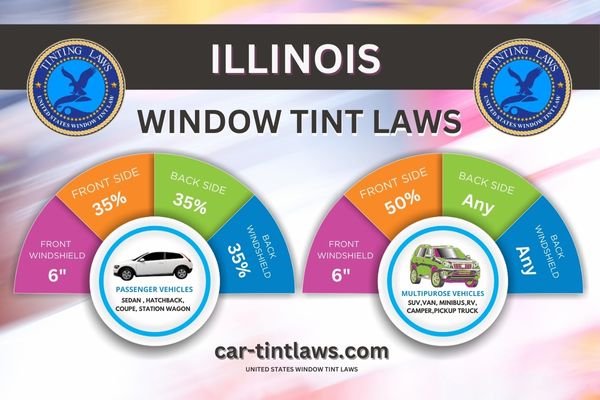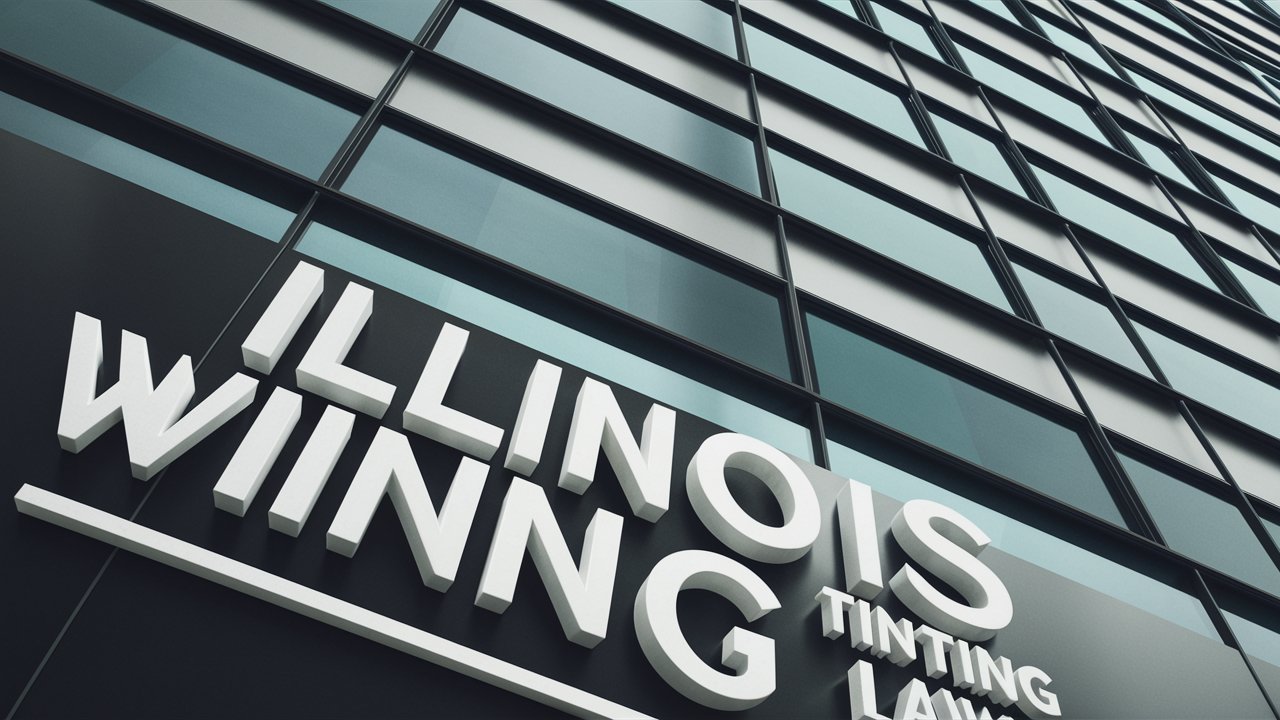Sailing Illinois’ window tinting laws can feel like walking a tightrope. You’re probably aware that the state has stringent regulations about how dark and reflective your car windows can be.
But did you know that even a slight deviation from the rules could result in hefty fines, ranging from $50 to $500?
And that’s just for the first offense. If you’re curious about how medical exemptions work or what kind of tint is actually legal, there’s much more you need to uncover to stay compliant and avoid penalties.
Window Tint Darkness in Illinois
When considering tint darkness for your vehicle in Illinois, there are different requirements based on the type of vehicle.
For sedans, front side windows must allow more than 35% of light to pass through, while rear windows need to maintain a minimum visible light transmission (VLT) of 35%.
On the other hand, SUVs and vans can have front side windows that allow over 50% of light, but their back side windows and rear windshields can be tinted to any level of darkness.
Tint darkness for sedans:
- Windshield: Non-reflective tint is allowed on the top 6 inches of the windshield.
- Front Side windows: Must allow more than 35% of light in.
- Back Side windows: Must allow more than 35% of light in.
- Rear Window: Must allow more than 35% of light in.
Tint darkness for SUV and Vans:
- Front Side windows: SUVs and vans in Illinois are required to have a minimum Visible Light Transmission (VLT) of 50% on the front side windows, ensuring at least 50% of light can pass through for visibility and safety.
- Back Side windows: There are no restrictions on the VLT for back side windows and rear windows, allowing for any level of darkness to be chosen for privacy and aesthetic preferences. However, if the rear windows are tinted, dual side mirrors are required for adequate visibility.
- Tint Color: Illinois window tinting laws for SUVs and vans do not specify any restricted colors, providing flexibility in choosing tint color options that comply with state regulations.
Window Tint Reflection in Illinois
When it comes to window tint reflection in Illinois, you’ll need to know the specific rules for different types of vehicles.
For sedans, both the front and back side windows must be non-reflective to comply with state regulations.
SUVs and vans must also have non-reflective tint on all side windows, ensuring they adhere to the same legal standards.
Tint reflection for sedans:
- Front Side windows: Must have non-glare tint to comply with state regulations.
- Back Side windows: Must have non-reflective window tint to adhere to Illinois tint laws.
- The regulation ensures that tint reflection does not impede visibility and safety on the road.
- Non-glare window tint balances privacy and visibility effectively.
- Reflective tints can cause glare and reduce driver visibility.
- Compliance with these laws is essential to prevent fines and penalties.
- Adhering to tint reflection requirements is crucial for avoiding legal issues.
- Following Illinois tint laws contributes to safer driving conditions.
- Non-glare window tint provides clarity for improved visibility.
- Stay compliant to enjoy a hassle-free driving experience.
Tint reflection for SUV and vans:
- Front Side windows: Must have non-glare tint.
- Back Side windows: Must have non-glare tint.
Other Illinois window tint rules and regulations
- Side Mirrors: No restrictions.
- Restricted Colors: In Illinois, all tint colors are permitted.
- Certificates: Manufacturers of film do not need to certify the film they sell in the state.
- Stickers: There is no requirement for a sticker or label to indicate legal tinting on your vehicle’s windows.
- Medical Exceptions: Illinois offers medical exemptions for specific tint requirements. Individuals with certain medical conditions can use a darker tint, but details on the specific terms of the exemption should be consulted in Illinois state law.
- Penalties: Failure to comply with tint regulations in Illinois could result in a ticket and associated costs.

Medical Exemptions for Window Tint Rules in Illinois
If you have a medical condition that necessitates special window tinting, you’ll need to obtain documentation from a licensed physician to qualify for an exemption in Illinois.
Certain medical conditions, such as porphyria or albinism, may make you eligible for these medical exemptions.
To initiate the exemption process, your physician must provide detailed medical documentation outlining your need for reduced light exposure.
This documentation is then submitted to the Illinois Secretary of State.
Once your application is reviewed and approved, you’ll receive an exemption certificate.
This certificate confirms your permission to have a darker window tint and must be carried with you whenever you’re driving.
Additionally, you’ll receive a special sticker for your windshield, indicating your approved status to law enforcement officers.
It’s important to follow these steps carefully to guarantee compliance with Illinois’s window tint rules.
The exemption process ensures that those with genuine medical needs can protect their health while driving, without facing penalties.
Always carry your exemption certificate and display the special sticker on your windshield, so you can drive confidently knowing you’re adhering to Illinois regulations.
Illinois Window Tint Ticket Cost
Getting caught with illegal window tint in Illinois can cost you anywhere from $50 to $500 for the initial violation.
The fines for a first-time offense are designed to encourage compliance with state laws and help you avoid further legal issues.
If you happen to get a second violation, or if the offense is classified as a class C misdemeanor, the penalties increase, ranging from $100 to $500.
Continuous violations can lead to escalating consequences, including potentially higher fines and more severe penalties.
Adhering to Illinois window tint laws is essential not just for avoiding fines but also for staying out of legal trouble.
Compliance with these regulations saves you time, energy, and money by preventing unnecessary legal issues.
Understanding and following these laws is vital for all vehicle owners in Illinois.
Non-compliance can lead to penalties that far outweigh the cost of adjusting your window tint to meet legal standards.
Ensuring your vehicle adheres to Illinois window tint regulations is a straightforward way to avoid fines and other legal consequences.
Make sure your window tint complies with the law to maintain a hassle-free driving experience.
Illinois Vehicle Code Overview
The Illinois Vehicle Code outlines specific regulations for window tinting, including the permitted darkness levels, reflective properties, and placement on your vehicle’s windows.
You must comply with these guidelines to avoid fines and guarantee road safety.
Additionally, the code provides a process for obtaining medical exemptions if you have a condition that necessitates special tinting.
Tint Darkness Limits
When it comes to tint darkness limits under the Illinois Vehicle Code, sedans must have front side windows with a minimum Visible Light Transmission (VLT) of 35%.
For SUVs and vans, the front side windows require a VLT of at least 50%.
This guarantees that while you enjoy tinted windows, the vehicle remains compliant with state regulations.
For both sedans and SUVs, you can have any VLT on the back side windows and rear window, giving you flexibility in customizing your vehicle’s appearance and privacy.
Windshield tint is more restrictive. In Illinois, only the top 6 inches of your windshield can be tinted, and this tint must be non-reflective.
This rule is essential for maintaining clear visibility while driving, ensuring safety for you and others on the road.
The Illinois Vehicle Code also includes a 5% tolerance for variance in window tint darkness levels.
This means that if your windows are slightly off the specified VLT, you have a small margin for error.
Following these guidelines helps you stay within the law, guaranteeing that your vehicle remains both stylish and compliant with state regulations.
Reflective Tint Rules
While understanding tint darkness is important, it’s equally significant to know Illinois’ strict rules against reflective tint on both front and back side windows of sedans, SUVs, and vans.
Reflective tinting, which can give windows a mirrored appearance, is not allowed on these vehicles.
The Illinois Vehicle Code mandates that front side windows of sedans must have non-reflective tint only.
Additionally, back side windows of sedans are also required to adhere to the non-reflective tint regulations.
For SUVs and vans, the rules are equally strict.
Front side windows on these types of vehicles must use non-reflective tint, ensuring compliance with state laws.
Similarly, back side windows of SUVs and vans are prohibited from having reflective tint.
Adhering to these regulations is vital to avoid fines and maintain your vehicle’s road-legal status in Illinois.
Staying informed about these specific guidelines helps you maintain compliance and avoid any legal repercussions.
When tinting your vehicle’s windows, always opt for non-reflective tint on both the front and back side windows of sedans, SUVs, and vans, keeping in line with Illinois’ regulations.
Medical Exemption Process
Illinois’ Vehicle Code allows for medical exemptions to window tint regulations if you have documented proof from a licensed physician.
If you suffer from specific medical conditions like porphyria or albinism, you may qualify for these exemptions.
The exemption process involves obtaining a certificate from your physician, which outlines your medical condition and the necessity for window tint.
This documentation must then be submitted to the Illinois Secretary of State.
Once your medical exemption is approved, you’ll receive a special sticker for your windshield, indicating your exemption status.
It’s important to carry the certificate while driving, as proof of your approved exemptions in case you’re stopped by law enforcement.
The Secretary of State’s office plays an essential role in this process, ensuring that all documentation is verified and that the exemptions are granted accurately.
The approved exemptions allow you to have window tint that would otherwise be prohibited under standard Illinois laws. This is particularly beneficial if your condition makes you sensitive to sunlight.
By following the proper exemption process and maintaining the necessary documentation, you can legally have darker window tint to protect your health while driving.
References
Illinois Vehicle Code Chapter 12, Article V – Glass, Windshields, and Mirrors
Frequently Asked Questions
What Is the Darkest Tint Legal in Illinois?
You’ll want to know the legal limits on tint percentage. The darkest legal tint in Illinois varies: 35% for sedans, 50% for front SUV windows, with exceptions for medical reasons.
Visibility concerns, heat reduction, UV protection, and privacy benefits matter.
Can You Get Pulled Over for 15 Tint in Illinois?
You can get pulled over for 15% tint in Illinois. Police discretion and enforcement methods focus on vehicle visibility and safety concerns.
Legal consequences include fine amounts and potential penalties, though tint exemptions exist.
Is 20 Tint Darker Than 35?
Yes, in a tint comparison, 20% is darker than 35%. It offers better heat reduction, privacy levels, and aesthetic appeal.
However, consider visibility concerns, legal implications, the installation process, maintenance tips, and cost considerations.
What Are the Window Tint Laws in Illinois 2024?
In 2024, you’ll need to know Illinois’ tint percentage limits for vehicle visibility. Police enforcement guarantees safety regulations, balancing UV protection, heat reduction, and privacy concerns.
Car customization and tint installation must comply to avoid fines.
Conclusion
Getting your windows tinted in Illinois is like finding your way through a maze; it requires adherence to specific darkness, reflection, and VLT rules.
Non-compliance can lead to fines, reflecting the state’s dedication to safety.
Medical exemptions are available, indicated by a special windshield sticker for easy identification.
By understanding and following these regulations, you guarantee your vehicle meets legal standards, symbolizing a clear, unobstructed path to safe and lawful driving on Illinois roads.
